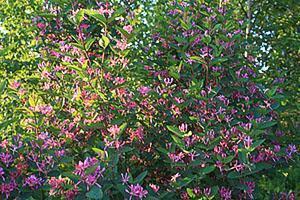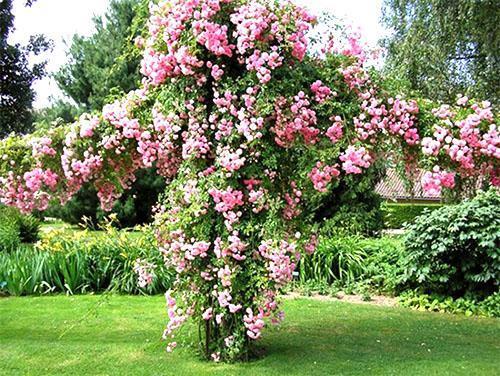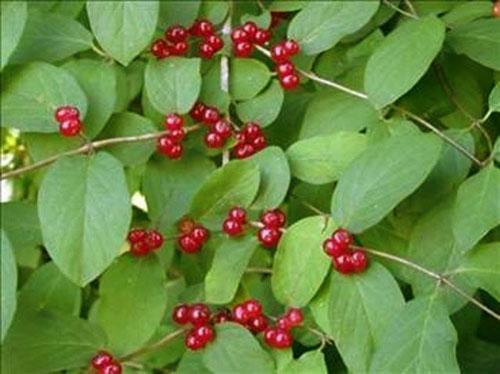Choose Tatar honeysuckle for your garden
 Among the many plants for creating a landscape, Tatar honeysuckle occupies a worthy place. There are many reasons for this, one of which is the unpretentiousness of the plant and its rapid growth. However, the cultural form is represented by several varieties, different in decorative qualities. The creation of a composition depends on knowing these features.
Among the many plants for creating a landscape, Tatar honeysuckle occupies a worthy place. There are many reasons for this, one of which is the unpretentiousness of the plant and its rapid growth. However, the cultural form is represented by several varieties, different in decorative qualities. The creation of a composition depends on knowing these features.
Biological characteristics and plant varieties

Within a month, it attracts bees and insects with paired two-lipped flowers on a long tube. Flowers have all shades from white to deep pink. As a result of pollination, by the end of summer, the bush is dotted with a bright shiny berry. The color of honeysuckle is constantly changing from the play of leaves, the shade of flowers and gradually pouring and reddening berries. See photo of honeysuckle honeysuckle.
 Young shoots of Tatar honeysuckle are hollow. The bark of young branches is brown, old ones - gray, with peeling stripes. Exfoliation of the bark is a common symptom of all types of honeysuckle. Tatar honeysuckle blooms in May or June, depending on the habitat. The plant is freed from foliage for the winter.
Young shoots of Tatar honeysuckle are hollow. The bark of young branches is brown, old ones - gray, with peeling stripes. Exfoliation of the bark is a common symptom of all types of honeysuckle. Tatar honeysuckle blooms in May or June, depending on the habitat. The plant is freed from foliage for the winter.
It should be noted that the fruits of honeysuckle are not only inedible, but poisonous. The age-old wisdom is confirmed. If there is poison in large quantities, medicine in small quantities. Only specialists know the exact dose between small and large.
Varieties and decorative signs of the plant
 A bush that keeps an attractive shape does not require much maintenance. Therefore, the owners of country estates are happy to plant a honeysuckle bush as a decorative ornament in spring, when the flower garden is still scarce. But this bush is pleasing to the eye even in summer, settling where others do not grow, on saline soil or in conditions of urban gas pollution.
A bush that keeps an attractive shape does not require much maintenance. Therefore, the owners of country estates are happy to plant a honeysuckle bush as a decorative ornament in spring, when the flower garden is still scarce. But this bush is pleasing to the eye even in summer, settling where others do not grow, on saline soil or in conditions of urban gas pollution.
Mainly, varieties of European selection have become widespread:
- Rosea.
- Hack Red.
- Elegans.
- Zabelii.
The Rozea bush in the Moscow region blooms at the end of May. It looks like a pyramid in a pink cloud. At the same time, garden lilacs, irises and peonies bloom and the garden becomes fabulous from beauty and fragrance. The berries of this variety are round, shiny bright orange. Tatar honeysuckle tolerates shade, drought, soil salinization and reproduces well by all known methods.
 The Hack Red honeysuckle bush is a sprawling, deep pink to crimson shade. The unusually abundant flowering lasts until mid-June. The fruits of this bush are dark red. The bushes of the Elegans variety have red flowers with yellow stripes, and the leaves are variegated with yellow spots and stripes. Zabelii honeysuckle blooms in burgundy color, and its berries are light red.
The Hack Red honeysuckle bush is a sprawling, deep pink to crimson shade. The unusually abundant flowering lasts until mid-June. The fruits of this bush are dark red. The bushes of the Elegans variety have red flowers with yellow stripes, and the leaves are variegated with yellow spots and stripes. Zabelii honeysuckle blooms in burgundy color, and its berries are light red.
In addition to these, there are varieties with white and yellow peduncles, with different flowering periods and different leaf shapes. You can choose the right plant, guided by the advice of experienced gardeners and specialists.
Honeysuckle Tatar planting and care
 There is a lot of information on how to grow honeysuckle. All forms of this species reproduce:
There is a lot of information on how to grow honeysuckle. All forms of this species reproduce:
- cuttings;
- layering;
- young growth;
- seeds.
Cuttings are carried out both by young shoots in the summer and by lignified cuttings, cut at the beginning of winter and stored in a prikop until spring. The substrate for the germination of cuttings is a mixture of sand and peat... The cuttings are treated with a root former, it is possible with heteroauxin, and placed at an angle of 45 degrees in a seedling box, covered with a film on top, in order to create their own microclimate in the greenhouse. After the appearance of the first leaves, the plant should be left to develop in a protected place, covered with spruce branches from frost for the winter. In the spring, plant the cuttings in a permanent place. The honeysuckle should be repotted when it gets warm. Under favorable conditions, flowering will begin next year.
It is possible to quickly propagate the plant, covering part of the bush when it becomes an adult, after three years. The honeysuckle bush is propagated by layering, which is dropped into the ground. At the same time, during the summer, the branch will take root, but it should only be transplanted to a permanent place next spring.
How to grow honeysuckle from seeds can be found in special literature, or on the website. But when grown from seeds, the varietal characteristics of the parent plant are not preserved. Therefore, the propagation of bushes is best done vegetatively.
 Caring for an adult plant is easy. An unpretentious plant can be quite decorative with minimal attention. Care and pruning of honeysuckle will add decorativeness to it. So, if the bush is thickened, then the branches will deviate and the bush will look neglected. Spring pruning and shaping will add more flowers and shape to the plant.
Caring for an adult plant is easy. An unpretentious plant can be quite decorative with minimal attention. Care and pruning of honeysuckle will add decorativeness to it. So, if the bush is thickened, then the branches will deviate and the bush will look neglected. Spring pruning and shaping will add more flowers and shape to the plant.
In the spring, the honeysuckle bush can be fed with complex fertilizer before flowering, and in the fall, add ash to the trunk circle. When honeysuckle is grown, as a garden decoration, caring for it should consist not only of watering and fertilizing, but also protecting it from pests and diseases. With the advent of diseases, beauty is lost not only in humans.
 Of the pests, honeysuckle leaves are very fond of aphids. But ticks and all kinds of bugs and caterpillars love this bush. Taking into account the fact that this shrub does not participate in the human food chain, it is worth processing it after a week and with such strong preparations as Actellic. The fact is that the pests that have bred on the bush will later move to cultivated plants.
Of the pests, honeysuckle leaves are very fond of aphids. But ticks and all kinds of bugs and caterpillars love this bush. Taking into account the fact that this shrub does not participate in the human food chain, it is worth processing it after a week and with such strong preparations as Actellic. The fact is that the pests that have bred on the bush will later move to cultivated plants.
Fungal, bacterial and viral diseases also do not bypass Tatar honeysuckle. Regular treatment with fungicides and treatment with folk remedies can help here. However, it is necessary to reduce nitrogen fertilization and add potassium and phosphates. They change the composition of the sap, and the plant is less exposed to pests. But it makes no sense to give up a beautiful bush. Not he, so another plant will become a source of settlement for uninvited guests, in the conditions of the constrained management of collective gardens.